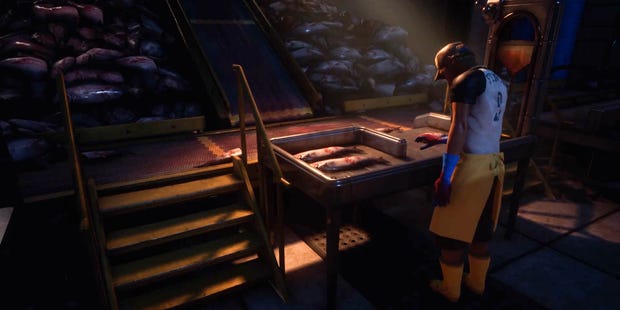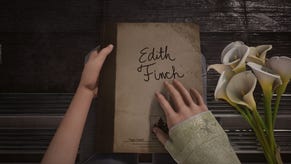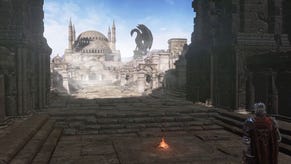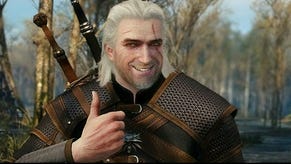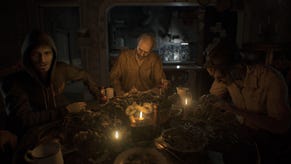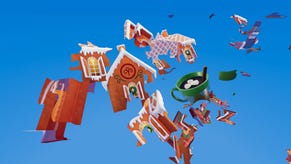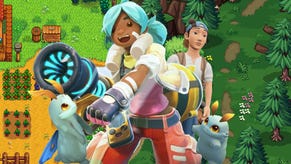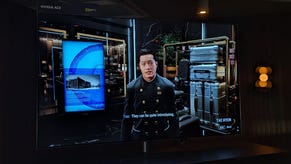State of the Art: How Edith Finch's most memorable scene works
On fish and fairytales
EDITH FINCH SPOILERS AHEAD. THIS IS A REALLY OBVIOUS WARNING SO CONSIDER YOURSELVES WARNED!
What Remains of Edith Finch [official site] is a home exploration story – an anthology of the lives of Edith's family members – where playable vignettes tell you what happened to each of them. Each vignette is a distinct tale with its own mood, its own rules. Here I sat down with Ian Dallas and we dug deep into the story of Lewis. Without giving too much away before the jump Lewis's story is probably the star of the game – not my personal favourite, but the one which showcases just how different and accomplished these vignettes actually are in the current landscape of games. Join us as we explore the world of fish and of fairytales...
The illustrations are a mixture of concept art and screenshots from Lewis's story and can be enlarged by clicking on them.
This art feature is slightly different from others I've done in that there are questions of set design and aesthetic which are less easily pinned to sketchbook pages or screenshots. There's an art of movement in Edith Finch and so the discussion necessarily strays into the theoretical and the mechanical as well as the imagery.
Lewis' story tells the tale of a young man working in a cannery in Seattle. As he works his monotonous shifts he retreats further and further into his imagination, conjuring up rich worlds to explore and to rule. Eventually he meets a grisly end as his inner and outer worlds collide at the business end of a cannery guillotine blade usually reserved for beheading salmon.
In creating the sense of these two lives intertwining you control elements in both realms as you play the vignette. With your mouse you're grabbing a fish, moving it to the blade in order to chop its head off and throwing it onto a conveyor belt. With WASD you're moving the character through increasingly rich imaginary environments and advancing the story on that front.
I settled into a rhythm of fish chopping which became so familiar that I was able to keep it going while my attention was almost entirely taken up by the imagination side of things. But if that's too stressful you can also just focus on one at a time and the game adapts, stopping the flow of fish until you clear the backlog or patiently waiting for you to walk the imaginary character to the next part of the world. You'll still need to chop a few fish because they're occasionally incorporated in the imagination world as obstacles to pass or they might start to obscure your vision but there's no fail state no matter how you approach the task.
As the real world recedes the imagination realm gets more vibrant and complex, taking up more room onscreen and more attention. All of the elements contrived to put me in the exact right state for the story Giant Sparrow were telling here and it's one of the vignettes I'll remember for a long time to come, hence why I wanted to unpick what's going on a bit. First, here's the vignette as a reminder of how it works:
The tale itself is based on The Coronation of Thomas Shap – a short story by Lord Dunsany. It tells the tale of a salesman who gradually divorces his soul from his day-to-day existence and goes on private flights of fancy. At first he is able to do so while also going through the motions of his daily existence, but eventually he ends up being institutionalised. You can read the whole thing online via the link but here's a snippet so you can see what I mean:
"They noticed that he was silent, and even absent at times, but they found no fault with his behaviour with customers, to whom he remained as plausible as of old. So he dreamed for a year, and his fancy gained strength as he dreamed. He still read halfpenny papers in the train, still discussed the passing day's ephemeral topic, still voted at elections, though he no longer did these things with the whole Shap – his soul was no longer in them."
For a long time during development Lewis met the same fate as Shap, but as the years of development wore on the story began to part ways from its source material and Lewis ended up going to his death, as is the case in all the Edith Finch stories.
Lewis didn't start out in a cannery. Shap's profession is left as a vague sales role in Dunsany's text so it was up to Giant Sparrow to figure out what worked. They tried out an old-fashioned telephone exchange where the player would need to move pins to connect calls – something that was making a demand on your attention as you tried to exist in two worlds at once.
The telephone exchange idea sounds like it's from the iteration of the game when it was set during the 1920s . It ping-ponged through through time while in development, going from the modern day to the early twentieth century and back. The cannery that the team ended up with is the result of a few different elements.
First is the association Dallas has with Washington state and salmon. It was both a literal presence and a symbolic one, encountered in supermarkets and local reservations as well as its use in Native American art from that region. It was also a way of referencing one of the older themes of the game: the sublime horror of nature.
"Early on the game was about the sublime horror of nature with less of an emphasis on family and more on what it feels like to be in the middle of a forest or those primal elements," says Dallas. "The contrast between the natural and the civilised world was very bound up in that. The initial jumping off point for the whole game was what it feels like to be scuba-diving underwater and look at the ground slope away into infinite darkness. Being a small thing in a very large, unfamiliar world. The cannery was a way of transmuting that into something ostensibly man-made but which took on these insane proportions."
When I got to the point where the game lets you walk around the cannery rather than just staring at your work space it reminded me of cathedrals and churches. There were high ceilings and tiered architecture which leads the visitor upwards towards the most important section. Light illuminates key portions and there's a theatricality to the space which is intended to dwarf a mere human. You could also look at the cannery and see the idea of forest spaces, with tall trees and shafts of light.
Fritz Lang's Metropolis and Charlie Chaplin's Modern Times are on Dallas's list of influences. Their futuristic and industrial flavours are joined by the etchings of Piranesi and the experimental apartment living project of Habitat 67.
For me, one of the key parts of the experience of walking through the cannery was the way it leads you upwards. It's an apotheosis of both kinds as you literally and metaphorically ascend to your coronation/beheading. It's a very effective final journey but one which only became so effective incredibly late in development.
"It's funny how many changes these things go through," says Dallas. "Close to the end we turned the camera around 180 degrees. Previously you had walked in on other side of the cannery. The last thing you did was walk up this little bridge that goes over the river and through these small doors."
The decision to see how it felt going from a smaller space (the locker room in the finished game) to the cavernous cannery floor across that small bridge proved to be a revelation.
"The mechanical underpinnings of evoking awe are helped substantially with a very sharp, brief turn. The moment in the Unfinished Swan [Giant Sparrow's previous game] where the labyrinth is first revealed has a similar structure. You're walking through a narrow, contained space and then suddenly you're in a giant space."
Dallas compares that 180 degree change in the cannery journey to being punched by a hand moving fast as opposed to one going slow. Generating a sharp shock is hugely important.
Lewis's placement in that scene is also key – originally he was a little to the left and people would either fail to notice him at all or not realise who he was. Now he's in the centre of the scene, facing away but illuminated by God rays.
To me the facing away is important because it helps you feel that divergence. This person who Lewis is in the real world is now at a distance. A crucial connection has been lost.
But let's go back to how the setting is introduced and how Dallas's team ease players into the patting your head and rubbing your tummy gameplay which mark this section out.
At first the temptation was to make the interactions very gamey. You'd need to manage resources or keep to a particular level of output: "Early on when we were making this cannery sequence we had the concept of a boss who was running around occasionally monitoring you so you'd need to make sure you stayed within quota."
There were meters to monitor, buckets to fill, fish to chop, fingers to be careful NOT to chop – all kinds of resources and potential fail states. Dallas adds, "The main thing I remember is how much simpler we had to make things over multiple passes."
That's not an unusual thing in the design process as initial brainstorming often adds a heap of ideas while development sees the good ones refined and the bad ones junked. But here there was the added factor of dividing the player's attention. It's not just a case of being able to spend half your attention on one task and half on the other as if they're separate things – if it was, patting your head and rubbing your tummy wouldn't be the nightmare that it is.
Dallas puts it at about 25% attention on each of the tasks and the remaining 50% on just managing the multitasking. Obviously that's not scientific data but it serves to illustrate just how much more simplified the tasks needed to become to cope with the idea of having two worlds existing in parallel.
Simple tasks ended up being the more satisfying result. Players stopped panicking about the resource management and were freed up to explore or play with the interactions. It's something which felt more like the experience I'd imagined for Lewis, too. He was able to complete his job satisfactorily while off in his imagination so taking out fail states meant removing that dissonance if you as a player failed to be good at the "job".
"One particular place where we had a lot of problems was the moment where the imagination cloud first appears," says Dallas. It arrives onscreen as you're chopping fish, kind of like a slightly more wispy thought bubble from a cartoon, and contains the imagination world. The stumbling block was getting players to realise they could actually control the character in the imagination.
The problem as he sees it was twofold. Players weren't expecting an imagination cloud in the first place and they were also concentrating on chopping fish so were tuning out distractions like a cloud appearing on the screen.
"After the cloud appears the fish stop completely until you move far enough in the imagination cloud that we feel like you understand what's going on and we can start the fish again!"
If the fish didn't stop coming people couldn't deal with the cloud.
I think the thing that prompted me to explore the cloud world was actually an audio cue. The psychiatrist narrating the scene says something like "His mind began to…" and you only get the concluding "...wander" if you engage with the cloud. The unfinished sentence dangles unhappily in your ear, begging for a verbal resolution. It yanked me out of my fish trance and sent me searching for the interaction which would give me that payoff.
Once the game ascertains that you've started exploring both worlds through reaching a particular point in the imagination world you can generally choose to chop fish or not. There are a few points where the worlds collide with a compulsory chop, though. At one point a fish blocks a doorway and performing a real-world chop clears the way.
These compulsory chops punctuate the vignette so you as a player never quite lose the sense of the cannery, even if you're entirely focused on the imagination cloud. They also tie the realms together with action in the real world producing an effect in the imagined one. The final chop of Lewis's coronation/decapitation flips that dynamic. Lewis is making decisions in the imagined world and their consequences are in the real one.
I didn't realise there was no fail state when I played the vignette the first time. I was very diligent as a cannery employee and thus never had a backlog of salmon. You'd be forgiven for thinking I'd been to cannery school. "As a rule journalists tend to be very responsible about fish chopping," Dallas tells me. I explain that I was playing at having a grown up job.
The imagination realm also takes a stylised trip through videogame aesthetics as the story continues. You start off with a very simple top-down maze to navigate, then switch to something from the isometric referencing isometric games and onward, culminating in the first-person walk towards the guillotine, surrounded by cheering crowds. As I played I wondered if this was going to end up as an explicit reference – a retreat into gaming as an escape, or something along those lines – but it never tips over into such an overt statement. Instead it's a game-literate device to show how his imagination is strengthening and developing.
That wasn't always the case. Initially, when the game was first set in the present day, the connection was more overt. You started with a top-down blocky aesthetic and moved towards the first person in a similar way but there were tiles as terrain to navigate, monsters to fight and so on. It was more gamey.
Between then and the finished game Edith Finch went back in time to the 1920s and videogames stopped making sense as a reference point. At the same time the art style shifted, inspired by pictorialism which is a somewhat broad term but it generally refers to photography manipulated to express emotion or to highlight the creator's artistry rather than have them disappear behind a veneer of faithful recreation. It can be dreamlike and sometimes surreal and leans towards romanticism and moodiness.
I can see why you might try that as an aesthetic for Edith Finch and some echoes of that period have remained in the game. The same is true of Orientalism which the team also used as an influence in that setting. Orientalism is a term for how Western artists would depict aspects of Eastern cultures (there's a whole bunch of problematic stuff to pick through if you do delve into that strand of art including power dynamics, over-simplifications, colonialist fears, stereotypes and a whole heap of fetishisation). I've been thinking about that set of influences since we did this interview and I think the exoticism is used purposely to heighten the difference between the cavernous and drab cannery and the bright, simplistic pull of the imagination. It's landed as a kind of amalgamated fantasy world of the kind you might find in a children's storybook.
But ultimately the family was transplanted back into contemporary surroundings and the vignette reoriented to reflect the move. Thus we are left with the videogame analogy but with its sharper edges filed down. You catch glimpses of it - for example at one point Lewis leaps onto a flagpole and triggers a familiar blooping noise as the flag is raised in a nod to Mario games. But escape for Lewis is broader than a retreat into play. As if to underline that point the set dressing of Lewis's room makes it clear from the start that marijuana played a large part in his life. The psychiatrist's letter which is used as a narrative for the story also mentions substance abuse and how it was after getting sober and being faced with his mundane job that Lewis starts exploring imagined worlds.
"I think this was the first point where we really understood what our bedrooms should look like in the game," says Dallas. "We'd been developing this game – ultimately it took us about 4-and-a-half years – and it was 3 years in where we'd done pretty much all the bedrooms and had the skeleton of the house and it occurred to me, we should make Lewis a pothead."
Realising Lewis needed to be that kid – a version of the high school burnout – meant trying to describe that character using his bedroom. There are marijuana leaf posters, there's a blacklight, smoking paraphernalia, a tie-died sheet of fabric on the ceiling, psychedelic patterns on soft furnishings and so on. It's an easily legible bedroom, variants of which I've visited as a teenager.
That exercise in digital interior design is what freed the team up to treat the other characters and their spaces as more archetypal.
The initial intention was to avoid being too broad with characterisation but that didn't gel with only spending a few minutes in each environment, if that. To get a sense of the characters immediately would require broader strokes Dallas explains that there was still room for nuance after that first aesthetic blast but the blast was important to set the tone. At first glance Lewis's space is supposed to sketch that high school burnout character then you dig around to flesh that out and find the parts which are distinctly "Lewis".
Something which, I think, helps is that you encounter a lot of young people's bedrooms early on. I have tiny relatives and what they're interested in comes across loud and clear in their rooms – favourite toys are in easy reach or spread out on the floor, branded bedspreads tell you which franchise currently holds their heart in its corporate hand, drawings adorn walls and so on and so on. My favourite thing is when kids share a room and there's that super obvious dividing line between Your Stuff and My Stuff.
It's a similar story with teenagers. I had a Kurt Cobain poster on one wall, photos of friends on another, maths equations I needed to memorise painted at eye level, albums I didn't mind people seeing, my pet cacti (Jonny and Colin) and all manner of other junk. If you'd walked in you'd certainly know what I valued and what I was okay with people learning about me.
Your room is often this expression of who you are, directed both outward and, as Dallas observes, to the person whose room it actually is as a kind of affirmation. "Teenagers need to tell themselves [who they are] too, right? They're still experimenting with it. It's like throwing something at the wall to see what sticks - they're literally putting things on the wall to see! Am I the kind of person who would have a poster for The Clash? Let me try this thing out."
The last question I have is about the general mood of the game. It's focal points are these tragedies, yet I don't recall ever feeling sad as I played. I think this ties into both the way the developers present the scenes and my own theory about the curse which afflicts the Finches. At the root of both is the sense that these people all die as a result of doing something they want to do. They have adventures, they push boundaries, they pursue their own daft projects... The outcome is tragedy but there's no raging against a long illness or other types of overt sadness inherent in the vignettes you actually play. The result of how the Finch family prefer to go about things is not often a long life but an interesting one, or at least an interesting vignette.
"Hopefully the stories are about people getting what they want but not necessarily in the way they expected," is how Dallas puts it. "I definitely wasn't expecting that we would hear from so many players that this game had made them cry."
There were no tears during the game's many playtests but Dallas suggests that might be because the testers were playing segments of the game or didn't have the full effect as audio or visuals or design were still being worked on. There's a story about baby Gregory and he drowns in the bath, but the presentation of that death is a wonderful Fantasia-type choreographed bath sequence involving all of his bath toys. I think if you played it without context it would seem uplifting and surreal. In context it has the weight of inevitable death and taps into fears anyone who has had to bathe a wriggling child will recognise. For me it was possibly my favourite scene because it was effective without being mawkish or sentimental.
Dallas adds that having children of your own affects how you experience the game because it affects the emotional impact of particular things. "Particularly scenes of violence or threats to children really viscerally affect them in ways they did not before they had children." The risks associated with baby bathtime are written in no uncertain terms on the label of the baby tub I have at home for tiny relatives and when early evening rolls around that warning prickles around in your brain throughout the mundane task.
"It was obvious to us then that players already brought so much anxiety and concern with death and the fragility of life and the shortness of existence that we didn't need to call it out. It was something that was there from context," says Dallas.
With Lewis the whole final scene has this joyous cacophony and this ascension even as you know he's going to his death. It's a peculiar mixture and one which makes Edith Finch a real point of difference in the gaming landscape.
"[The idea of the curse] is definitely helpful as a skeleton to hang everything else on but it's primarily trying to encourage players to think about how these things touch on their own life," sums up Dallas. "That seems like a much more interesting question: 'What do I think about the knowledge that I will be dead before long?' There is so much more grist there than what Edith is going through."
